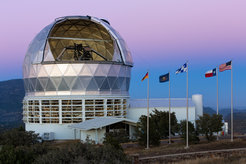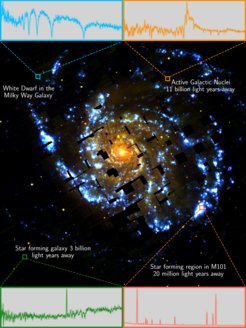HETDEX Project On Track to Probe Dark Energy
Three years into its quest to reveal the nature of dark energy, the Hobby-Eberly Telescope Dark Energy Experiment (HETDEX) is on track to complete the largest map of the cosmos ever. The team will create a three-dimensional map of 2.5 million galaxies that will help astronomers understand how and why the expansion of the universe is speeding up over time. Scientists in Munich and Garching have contributed to the design of the survey strategy, planning and execution as well as developing key software and data management tools for the cosmology data analysis.

“HETDEX represents the coming together of many astronomers and institutions to conduct the first major study of how dark energy changes over time,” said Taft Armandroff, Director of The University of Texas at Austin’s McDonald Observatory. The survey began in January 2017 on the 10-meter Hobby-Eberly Telescope (HET) at McDonald Observatory. Today, the survey is 38% complete. Data reduction and analysis are continuing.
The survey works by aiming the telescope at two regions of the sky near the Big Dipper and Orion. For each pointing, the telescope records around 32,000 spectra, capturing the cosmic fingerprint of the light from every object within the telescope’s field of view. These spectra are recorded via 32,000 optical fibers that feed into more than 100 instruments working together as one. This assembly is called VIRUS, the Visible Integral-field Replicable Unit Spectrograph.
“We applied a completely new approach in terms of astronomical instrument building with VIRUS,” points out Ulrich Hopp, from the University Observatory Munich. “Instead of one complex instrument with a lot of tasks and capabilities, we built an essentially simple but powerful device, replicated it and put 78 of these modules together. For this to work, we needed to develop new strategies in terms of production and quality control.” This makes VIRUS one of the most advanced astronomical instruments in the world.

HETDEX is a blind survey, meaning that rather than pointing at specific targets, it records everything over a specific patch of sky. Then scientists go back through to the data later to sift out specific objects they want to study. To make the map needed for the dark energy project, they are combing through a billion spectra looking for examples of a specific type of galaxy. The light from these galaxies has travelled for 10 billion to 11.7 billion years, so they represent an epoch when the universe was only a few billion years old.
“VIRUS has proven to be an extremely powerful instrument to search for galaxies in the high-redshift universe,” says Maximilian Fabricius, who has led the software development at the Max Planck Institute for Extraterrestrial Physics. “Due to the large field-of-view, we can now detect these galaxies in numbers that exceed anything that was possible before by orders of magnitude. At the same time, its sensitive instrumentation allows us to study low surface brightness structures that were inaccessible to other optical instruments before.”

This false-color image of the Pinwheel Galaxy (Messier 101) shows the power of the VIRUS instrument built for the HETDEX survey. The image is a mosaic made up of the central portion of 21 VIRUS pointings across a region of sky about half the size of the full Moon, with some small gaps in coverage. The colors show the contrast between young stars (blue/white) and older stars (red/orange).
Unlike a regular astronomical image, which is essentially made using a sophisticated camera, this image comprises more than 1 million spectra. That is, for every point on this image, VIRUS has recorded the ‘cosmic fingerprint’ of the light using one of its 32,000 optical fibers.
The breakout boxes show just four examples of the ‘cosmic fingerprint’ of objects in this view. Clockwise from top left: a white dwarf in our galaxy, an active galaxy 11 billion light-years away, a star-forming region in the Pinwheel Galaxy 20 million light-years away, and a star-forming galaxy 3 billion light-years away.In future, an algorithm based on artificial intelligence will perform the automatic source classification. But the first manual inspection of several thousand sources already produced some interesting results. “We've measured spectra from quasars, local galaxies, stars, regions with extended Lyman-alpha emission and even meteors,” specifies Daniel Farrow at the Max Planck Institute for Extraterrestrial Physics, who is involved in the cosmology analysis. “Our main focus for the dark energy research are the high-redshift galaxies though, they tell us how fast the young Universe was expanding.”
The spectra of these distant galaxies carry information about how fast they are moving away from us as a result of the expansion of the universe. That will allow astronomers to determine how the rate at which the universe expands has changed over the eons, which is key to determining the nature of dark energy.
“The HETDEX data set is insanely exciting,” declares Eiichiro Komatsu at the Max Planck Institute for Astrophysics, who has been instrumental in the project from its start in 2003. “This is a data set that we have never seen before, a truly blind emission-line survey. Because of its novelty, we had to face numerous challenges when building the instrument, designing the survey, collecting and calibrating data, and analysing them to extract science. This has been an exciting journey over the last 17 years, and we are finally at the discovery stage for unravelling the mystery of dark energy.”
The HETDEX team expects to complete their observations by December 2023. In total, the completed survey will include one billion spectra.
More information:
HETDEX is a large international collaboration. The project is led by The University of Texas at Austin McDonald Observatory and Department of Astronomy with participation from Penn State University; Ludwig Maximilians University, Munich; the Max Planck Institute for Extraterrestrial Physics; the Institute for Astrophysics, Gottingen; the Leibniz Institute for Astrophysics, Potsdam; Texas A&M University; The University of Oxford; the Max Planck Institute for Astrophysics; The University of Tokyo; and the Missouri University of Science and Technology.














